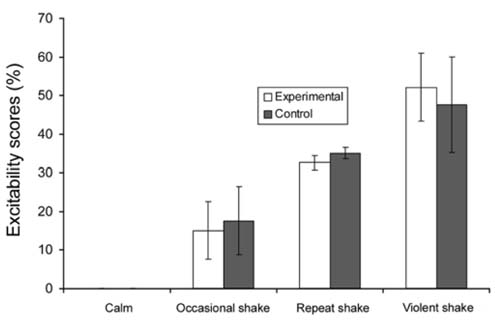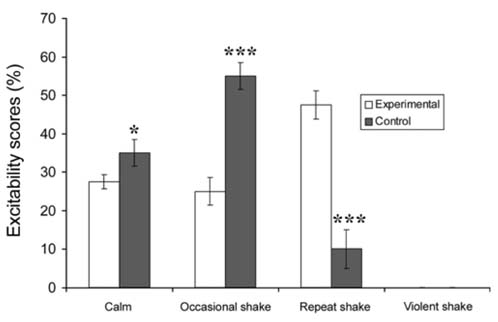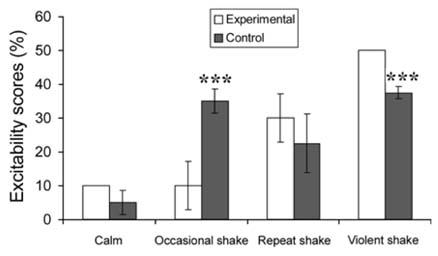J Vet Sci.
2006 Jun;7(2):127-131. 10.4142/jvs.2006.7.2.127.
Excitability scores of goats administered ascorbic acid and transported during hot-dry conditions
- Affiliations
-
- 1Department of Veterinary Physiology and Pharmacology, Faculty of Veterinary Medicine, Ahmadu Bello University, Zaria, Nigeria.
- 2College of Agriculture and Animal Science, P.M.B. 2134, Ahmadu Bello University, Mando Kaduna, Nigeria. mnsalka@yahoo.com
- KMID: 1059197
- DOI: http://doi.org/10.4142/jvs.2006.7.2.127
Abstract
- In this study, we investigated the effect of ascorbic acid (AA) administration on goat excitability due to transportation. Ten goats administered AA (p.o.) at 100 mg/kg of body weight before transportation served as the experimental group, and seven goats administered only 10 ml/kg of sterile water (p.o.) served as controls. Excitability scores were recorded for each goat; when weighed, before, immediately after, and 3 h after 8 h of transportation. A score of one to four was allocated to each goat; higher scores represent greater excitability. Immediately after transportation, excitability scores decreased significantly, especially those of control goats (p < 0.001). At 3 h posttransportation, the excitability scores of animals in the experimental group were not significantly (p > 0.05) different from their pre-transportation normal values, whereas those of control goats were significantly lower (p < 0.01). The correlation i.e. the relationship between excitability score values and percent excitability (percentage of goat with particular excitability score) for different excitability score group 3 h post-transportation was positive and highly significant (p < 0.001), in both experimental and control goats. Our results indicate that road transportation induces considerable stress (depression) in goats as evidenced by a lower excitability score posttransportation. Moreover, the administration of AA pretransportation facilitated the transition from a state of depression to excitation. In conclusion, AA administration to animals prior to transportation may ameliorate the depression often encountered after road transportation.
Keyword
MeSH Terms
Figure
Reference
-
1. Atkinson PJ. Investigation of the effects of transport and lairage on hydration state and resting behavior of calves for export. Vet Rec. 1992. 130:413–416.
Article2. Ayo JO, Oladele SB, Fayomi A, Jumbo SD, Hambolu JO. Body temperature, respiration and heart rates in the Red Sokoto goat during the harmattan season. Bull Anim Health Prod Afr. 1988. 46:161–166.3. Ayo JO, Oladele SB, Fayomi A. Behavioral reactions of cattle to stress situations: A review. J Agric Technol. 2002. 8:15–20.4. Balz F. Vitamin-C intake. Nutr Dis. 2003. 14:1–18.5. Broom DM. Causes of poor welfare in large animals during transport. Vet Res Commun. 2003. 27:Suppl 1. 515–518.
Article6. Brown SN, Knowles TG, Edwards JE, Warriss PD. Behaviour and physiological responses of pigs to being transported for up to 24 hours followed by six hours recovery in lairage. Vet Rec. 1999. 145:421–426.
Article7. Chervyakov DK, Yevdokimov PD, Vishker AS. Drugs in Veterinary Medicine. 1977. Moscow: Kolos Publishing House;496.8. Devendra C, McLeroy GB. Goat and Sheep Production in the Tropics. 1982. UK: Longman Group;89–100.9. Fazio E, Ferlanzzo A. Evaluation of stress during transport. Vet Res Commun. 2003. 27:Suppl 1. 519–524.
Article10. Grandin T. Assessment of stress during handling and transport. J Anim Sci. 1997. 75:249–257.
Article11. Hartung J. Effects of transport on health of farm animals. Vet Res Commun. 2003. 27:525–527.
Article12. Ladmakhi MH, Buys N, Dewil E, Rahimi G, Gecuypere E. The prophylactic effect of Vitamin C supplementation on broiler ascites incidence and plasma thyroid hormone concentration. Avian Pathol. 1997. 26:33–44.
Article13. Igono MO, Molokwu ECI, Aliu YO. Body temperature responses of Savanna Brown goat to the harmattan and hot-dry season. Int J Biometeorol. 1982. 26:225–230.
Article14. Jindal SK. Effect of climate on goats: a review. Ind J Dairy Sci. 1980. 33:285–293.15. Kannan G, Terrill TH, Kouakou B, Gelaye S, Amoah EA. Simulated preslaughter holding and isolation effects on stress responses and live weight shrinkage in meat goats. J Anim Sci. 2002. 80:1771–1780.
Article16. Kondratyev VC. Smirnov AM, Konapelko PY, Pushkorev RP, Postnikov VC, Urajayev NA, Belyakov IM, Dugin GL, Kondratyev VC, editors. Analysis of blood system. Clinical Examination of Internal and Non-infectious Disease of Livestock. 1988. Moscow: Agropromizdat;160–175.17. Knowles TG, Warriss PD, Brown SN, Edwards JE. Effects on cattle of transportation by road for up to 31 hours. Vet Rec. 1999. 145:575–582.
Article18. Liakakos D, Doulask NL, Ikkas D, Jouramani G, Anoussakis C, Vlachos P. Inhibitory effect of ascorbic acid (Vitamin C) on cortisol secretion following adrenal stimulation in children. Clin Chim Acta. 1975. 65:251–255.
Article19. Nikitchenko IN, Plyaschenko SI, Zenkov AC. Stresses and Productivity of Farm Animals. 1988. Minsk: Urajai Publishing House;200.20. Plyaschenko SI, Sidorov VT. Stresses in Farm Animals. 1987. Moscow: Agropromizdat;192.21. Saito T. Functional study of the central nervous system for farm animal husbandary. Anim Sci J. 2002. 73:77–82.
Article22. Strydom NB, Kotze HF, Rogers GG. Effect of ascorbic acid on rate of heat acclimatization. J Appl Physiol. 1976. 41:202–205.
Article23. Tauler P, Aguilo A, Gimeno I, Fuentespina E, Tur JA, Pons A. Influence of Vitamin C diet supplementation on endogenous antioxidant defences during exhaustive exercise. Pflugers Archiv. 2003. 446:658–664.
Article24. Voisinet BD, Grandin T, O'Connor SF, Tatum JD, Deesing MJ. Bos indicus - cross feedlot cattle with excitable temperaments have tougher meat and higher incidence of borderline dark cutters. Meat Sci. 1997. 46:367–377.
Article25. West JW. Effect of heat-stress on production in dairy cattle. J Dairy Sci. 2003. 86:2131–2144.
- Full Text Links
- Actions
-
Cited
- CITED
-
- Close
- Share
- Similar articles
-
- Ascorbic Acid Determination in Aqueous and Vitreous Humor of the Rabbit
- Effects of Ascorbic acid on the Intraocular Pressure and Serum Osmolarity in Rabbits
- The Effect of Ascorbic acid on Endotoxin-induced Fibrosis
- Change of Renal Excretion of Ascorbic Acid in Children
- Effect of L-Ascorbic Acid and DL-alpha-Tocopherol on the Activation and Binding of 2-Acetylaminofluorene to Rat Liver Nuclear Macromolecules in Vivo




